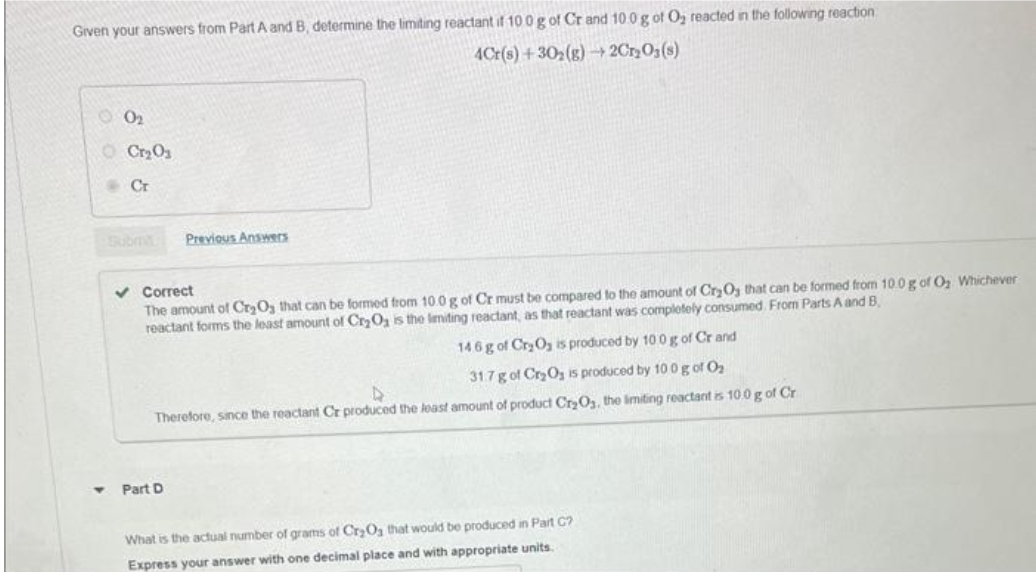Given your answers from Part A and B, determine the limiting reactant if 10 0 g of Cr and 10.0 g of O₂ reacted in the following reaction 4Cr(s)+30₂(g) →2Cr₂O3(s) Y 0₂ Cr₂O₂ Cr Subm Previous Answers ✓ Correct The amount of Cr₂O₂ that can be formed from 10.0 g of Cr must be compared to the amount of Cr₂Oy that can be formed from 10.0 g of O₂ Whichever reactant forms the least amount of Cr₂O₂ is the limiting reactant, as that reactant was completely consumed. From Parts A and B 146 g of Cr₂O₂ is produced by 10 0 g of Cr and 31.7 g of Cr₂O₂ is produced by 100 g of O₂ 4 Therefore, since the reactant Cr produced the least amount of product Cr₂O₂, the limiting reactant is 10.0 g of Cr Part D What is the actual number of grams of Cr₂O3 that would be produced in Part C? Express your answer with one decimal place and with appropriate units.
Given your answers from Part A and B, determine the limiting reactant if 10 0 g of Cr and 10.0 g of O₂ reacted in the following reaction 4Cr(s)+30₂(g) →2Cr₂O3(s) Y 0₂ Cr₂O₂ Cr Subm Previous Answers ✓ Correct The amount of Cr₂O₂ that can be formed from 10.0 g of Cr must be compared to the amount of Cr₂Oy that can be formed from 10.0 g of O₂ Whichever reactant forms the least amount of Cr₂O₂ is the limiting reactant, as that reactant was completely consumed. From Parts A and B 146 g of Cr₂O₂ is produced by 10 0 g of Cr and 31.7 g of Cr₂O₂ is produced by 100 g of O₂ 4 Therefore, since the reactant Cr produced the least amount of product Cr₂O₂, the limiting reactant is 10.0 g of Cr Part D What is the actual number of grams of Cr₂O3 that would be produced in Part C? Express your answer with one decimal place and with appropriate units.
General Chemistry - Standalone book (MindTap Course List)
11th Edition
ISBN:9781305580343
Author:Steven D. Gammon, Ebbing, Darrell Ebbing, Steven D., Darrell; Gammon, Darrell Ebbing; Steven D. Gammon, Darrell D.; Gammon, Ebbing; Steven D. Gammon; Darrell
Publisher:Steven D. Gammon, Ebbing, Darrell Ebbing, Steven D., Darrell; Gammon, Darrell Ebbing; Steven D. Gammon, Darrell D.; Gammon, Ebbing; Steven D. Gammon; Darrell
Chapter3: Calculations With Chemical Formulas And Equaitons
Section: Chapter Questions
Problem 3.119QP
Related questions
Question
Gg.61.

Transcribed Image Text:Given your answers from Part A and B, determine the limiting reactant if 100 g of Cr and 10.0 g of O₂ reacted in the following reaction
4Cr(s)+30₂(g) →2Cr₂O3(s)
0₂
Cr₂0₂
Cr
Previous Answers
✓ Correct
The amount of Cr₂O3 that can be formed from 10.0 g of Cr must be compared to the amount of Cr₂O3 that can be formed from 10.0 g of O₂ Whichever
reactant forms the least amount of Cr₂O₂ is the limiting reactant, as that reactant was completely consumed. From Parts A and B
146 g of Cr₂O₂ is produced by 10 0 g of Cr and
31.7 g of Cr₂O₂ is produced by 100 g of 0₂
Therefore, since the reactant Cr produced the least amount of product Cr₂O₂, the limiting reactant is 10.0 g of Cr
Part D
What is the actual number of grams of Cr₂O3 that would be produced in Part C?
Express your answer with one decimal place and with appropriate units.
Expert Solution
This question has been solved!
Explore an expertly crafted, step-by-step solution for a thorough understanding of key concepts.
This is a popular solution!
Trending now
This is a popular solution!
Step by step
Solved in 2 steps with 2 images

Knowledge Booster
Learn more about
Need a deep-dive on the concept behind this application? Look no further. Learn more about this topic, chemistry and related others by exploring similar questions and additional content below.Recommended textbooks for you

General Chemistry - Standalone book (MindTap Cour…
Chemistry
ISBN:
9781305580343
Author:
Steven D. Gammon, Ebbing, Darrell Ebbing, Steven D., Darrell; Gammon, Darrell Ebbing; Steven D. Gammon, Darrell D.; Gammon, Ebbing; Steven D. Gammon; Darrell
Publisher:
Cengage Learning

Chemistry: The Molecular Science
Chemistry
ISBN:
9781285199047
Author:
John W. Moore, Conrad L. Stanitski
Publisher:
Cengage Learning

Chemistry
Chemistry
ISBN:
9781305957404
Author:
Steven S. Zumdahl, Susan A. Zumdahl, Donald J. DeCoste
Publisher:
Cengage Learning

General Chemistry - Standalone book (MindTap Cour…
Chemistry
ISBN:
9781305580343
Author:
Steven D. Gammon, Ebbing, Darrell Ebbing, Steven D., Darrell; Gammon, Darrell Ebbing; Steven D. Gammon, Darrell D.; Gammon, Ebbing; Steven D. Gammon; Darrell
Publisher:
Cengage Learning

Chemistry: The Molecular Science
Chemistry
ISBN:
9781285199047
Author:
John W. Moore, Conrad L. Stanitski
Publisher:
Cengage Learning

Chemistry
Chemistry
ISBN:
9781305957404
Author:
Steven S. Zumdahl, Susan A. Zumdahl, Donald J. DeCoste
Publisher:
Cengage Learning


Chemistry: An Atoms First Approach
Chemistry
ISBN:
9781305079243
Author:
Steven S. Zumdahl, Susan A. Zumdahl
Publisher:
Cengage Learning

Chemistry for Engineering Students
Chemistry
ISBN:
9781337398909
Author:
Lawrence S. Brown, Tom Holme
Publisher:
Cengage Learning